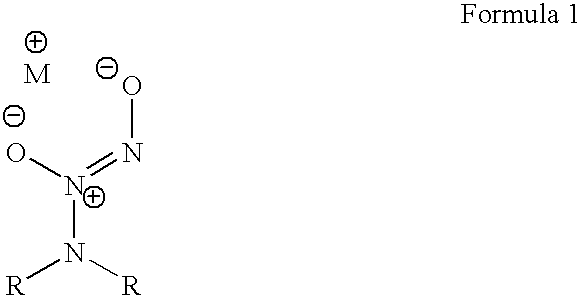Secondary Amine Containing Nitric Oxide Releasing Polymer Composition
a technology of nitric oxide and amine, which is applied in the field of nitric oxide (no) donating polymers, can solve the problems of irreparable damage, persistent risk of thrombogenesis and restenosis, and injury of the vessel wall at the site of balloon expansion or stent deploymen
- Summary
- Abstract
- Description
- Claims
- Application Information
AI Technical Summary
Benefits of technology
Problems solved by technology
Method used
Image
Examples
example 1
Synthesis of the Polymer of Formula 5
[0068]
[0069]Glycidyl methacrylate (9.02 g), n-hexyl methacrylate (21.03 g), 1,4-dioxane (59.98 g) and of AIBN (240 mg) were mixed in a 120 mL bottle, which was sealed and purged with nitrogen for 30 minutes. The bottle was heated at 60° C. for 3 hours with stirring. The polymer was purified by repeated precipitation in methanol from dichloromethane solution. After drying in a vacuum oven at 45° C. overnight, a copolymer of with n-hexyl methacrylate (64 mol %) and glycidyl methacrylate (36 mol %) was obtained. The polymer has a number average molecular weight of 130,075 and PDI of 2.02 according to GPC (THF, 35C and polystyrene standards). The glass transition temperature of the polymer is 11° C.
example 2
Conversion of the Epoxide Groups to Multiple Amine Groups in the Side Chains
[0070]
[0071]2.0 g of polymer from example 1 was dissolved in 8 mL THF. Separately another solution was prepared by mixing 23.9 mL of diethylenetriamine with 12 mL of THF. The polymer solution was added to the diethylenetriamine solution dropwise under agitation. The mixture was heated at 50° C. in an oil bath for three days. The resulting polymer was purified by precipitation into deionized water from THF solution. The 1H NMR spectrum in d4-methanol indicated the disappearance of the epoxide functional groups and the appearance of new peaks at around 2.7 ppm corresponding to the NCH2 groups.
example 3
Synthesizing a Secondary Amine Functionalized Dendrimer
[0072]A dendrimer with a surface of primary amine functional groups is reacted with 1,2-epoxypropane producing 2-hydroxypropylimine surface function groups on the dendrimer.
[0073]The 2-hydroxypropylimine can be reacted with the polymer of Example 1 to give a secondary amine functionalized dendrimer linked to the polymer.
PUM
| Property | Measurement | Unit |
|---|---|---|
| Tg | aaaaa | aaaaa |
| PDI | aaaaa | aaaaa |
| Tg | aaaaa | aaaaa |
Abstract
Description
Claims
Application Information
 Login to View More
Login to View More - R&D
- Intellectual Property
- Life Sciences
- Materials
- Tech Scout
- Unparalleled Data Quality
- Higher Quality Content
- 60% Fewer Hallucinations
Browse by: Latest US Patents, China's latest patents, Technical Efficacy Thesaurus, Application Domain, Technology Topic, Popular Technical Reports.
© 2025 PatSnap. All rights reserved.Legal|Privacy policy|Modern Slavery Act Transparency Statement|Sitemap|About US| Contact US: help@patsnap.com



